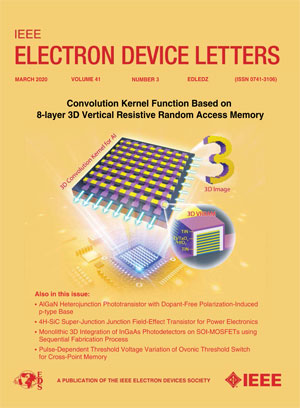Suppressed Transverse Mode Generation in TF-SAW Resonators Based on LiTaO3/Sapphire
IF 4.1
2区 工程技术
Q2 ENGINEERING, ELECTRICAL & ELECTRONIC
引用次数: 0
Abstract
Thin-film surface acoustic wave (TF-SAW) devices are important for wireless communication systems in the new age. Nevertheless, there are still some technical challenges including transverse mode suppression. To find out a practical solution for the challenge, this work theoretically and experimentally investigates transverse mode generation in TF-SAW devices based on LiTaO3/sapphire in which only mature and commercial materials are adopted. The devices with various Al thicknesses and wavelengths are simulated, and slowness curves, admittance curve and displacement distributions are all analyzed. A large range of wavelength from基于 LiTaO3/Sapphire 的 TF-SAW 谐振器中的抑制横向模式生成
薄膜表面声波(TF-SAW)器件对于新时代的无线通信系统非常重要。然而,目前仍存在一些技术难题,包括横向模式抑制。为了找到应对这一挑战的实用解决方案,本研究通过理论和实验研究了基于 LiTaO3/蓝宝石的 TF-SAW 器件中横向模式的产生。模拟了不同铝厚度和波长的器件,并分析了慢度曲线、导纳曲线和位移分布。结果发现,在 1.6~\mu $ m 到 4~\mu $ m 甚至更大的波长范围内,器件都能具有平坦的慢度曲线。基于钽铌酸锂/蓝宝石的 TF-SAW 谐振器在没有任何横向模式抑制设计的情况下被制造出来。波长从 1.6~\mu $ m 到 3.8~\mu $ m 的谐振器中的横向模式都被显著抑制,与理论结果吻合。我们认为,尽管横向模式仍然存在,但抑制已经足够了。这项工作提出了一种获得横向模式产生被抑制的TF-SAW器件的方法,显示了LiTaO3/蓝宝石结构的优势,促进了TF-SAW技术的发展。
本文章由计算机程序翻译,如有差异,请以英文原文为准。
求助全文
约1分钟内获得全文
求助全文
来源期刊

IEEE Electron Device Letters
工程技术-工程:电子与电气
CiteScore
8.20
自引率
10.20%
发文量
551
审稿时长
1.4 months
期刊介绍:
IEEE Electron Device Letters publishes original and significant contributions relating to the theory, modeling, design, performance and reliability of electron and ion integrated circuit devices and interconnects, involving insulators, metals, organic materials, micro-plasmas, semiconductors, quantum-effect structures, vacuum devices, and emerging materials with applications in bioelectronics, biomedical electronics, computation, communications, displays, microelectromechanics, imaging, micro-actuators, nanoelectronics, optoelectronics, photovoltaics, power ICs and micro-sensors.
 求助内容:
求助内容: 应助结果提醒方式:
应助结果提醒方式:


